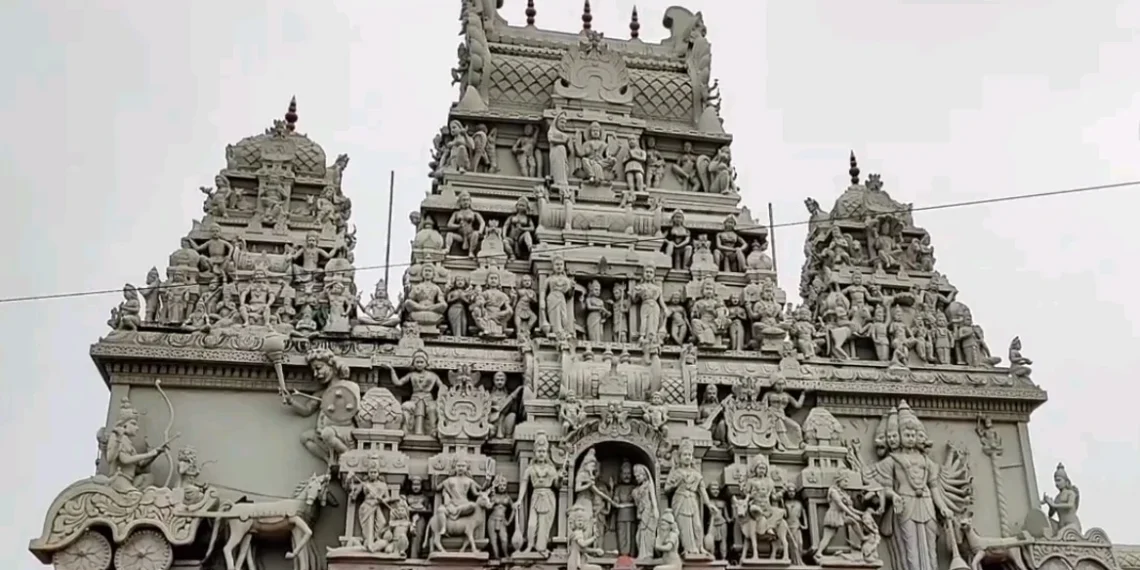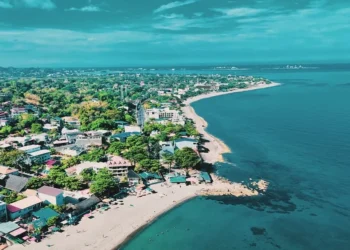In the lively city of Indore, Madhya Pradesh, lies the Annapurna Devi Temple dedicated to Goddess Annapurna, the deity of food and nourishment. Constructed by local Maratha families around 1959 AD, this temple houses a grand idol and colorful South Indian style. The current Annapurna Mandir was constructed in the 18th century by Maratha Peshwa Bajirao I. It draws many seeking blessings for prosperity and abundance.
Notable Fact: The temple’s 8-foot Annapurna idol, made of stone and gold, stands with four arms holding a bowl, spoon, and holy items, a rare sight in North India.
Overview of Annapurna Devi Temple
The Annapurna Devi Temple stands in Indore’s Palasia area, 6 kilometers from the city center. Known for its tall, colorful gate like South Indian shrines, it is a key stop for devotees in Indore. The temple houses not only Annapurna but also idols of Hanuman, Sivananda, and Kala Bhairava, making it a hub of faith. Its Dravidian-style towers, painted bright, shine in the city’s bustle. Devotees offer rice and sweets, believing Annapurna fills their homes with food. The temple trust keeps it as a lively holy spot, clean and strong, bustling with prayers daily.
History of Annapurna Devi Temple
Old tales say the temple was built in 1959 AD by Maratha families in Indore, inspired by Annapurna’s temples in Varanasi and South India. They sought her blessings for wealth and food in a growing city. The main idol, crafted in Ujjain, was placed with grand rites. In the 1960s, the temple grew with new halls and gates, funded by local traders. Unlike older shrines, it faced no raids, standing firm through time. In the 1980s, repairs added bright paint and tiles, keeping its South Indian look true. After 2000, the trust expanded its yard, making room for crowds. Long ago, devotees offered grains here, and tales of full kitchens spread wide. Now, it is a must-see for pilgrims in Indore, near the famous Khajrana Ganesh Temple.
Legend of Annapurna Devi Temple
In Hindu tradition, there are two well-known stories that explain the origins of this sacred temple.
One story tells of a time when Goddess Parvati playfully closed the three eyes of her consort, Lord Shiva. As a result, the entire universe was plunged into darkness. During this episode, Parvati’s radiant complexion faded, and she lost her form as Gauri, the fair one. Seeking to restore her appearance, she turned to Shiva for guidance. He advised her to offer food (anna daan) in the holy city of Varanasi. Following his advice, Parvati assumed the form of Annapurna—the goddess of nourishment—holding a golden vessel and ladle, and began distributing food to all in Varanasi.
Another belief tells a different tale. Once, Lord Shiva remarked that everything in the world, even food, was nothing more than an illusion (maya). This comment deeply upset Parvati, who is revered as the goddess of sustenance. To show the essential role of food, she caused all nourishment on earth to vanish. Without food, the world began to suffer immensely, and people grew weak with hunger. Eventually, Shiva himself felt the impact and approached Parvati, humbly asking her for food. Touched by his realization, she lovingly served him a meal and established a divine kitchen in Varanasi to feed her devotees.
Architecture of Annapurna Devi Temple
The Annapurna Devi Temple rises in a busy Indore lane, marked by a 100-foot gopuram gate, carved with gods and painted red, yellow, green, like Tamil Nadu’s shrines. Built in Dravidian style, its main hall has a low dome, not a spire, with thick walls of cream stone. Inside, the sanctum holds the 8-foot Annapurna idol, stone with gold plating, four-armed, holding a bowl, spoon, book, and beads, lit by oil lamps, real holy. Smaller shrines for Hanuman, Sivananda, and Kala Bhairava, all stone, sit in the hall.
The gopuram’s carvings show Annapurna feeding Shiva, a tale of her power, cut deep and clear. The yard, tiled and wide, buzzes with devotees. No river is near, but a small tank in the yard serves for holy dips. The temple’s walls tell Annapurna’s story—her gift of food—guiding them who pray.
Sculptures of Annapurna Devi Temple
The temple’s carvings shine on its gopuram gate. Annapurna’s form, feeding Shiva or holding her bowl, stands out bold and fine. Other gods, like Vishnu, Lakshmi, and Ganesh, line the gate, cut neat in stone, painted bright. The main idol, 8-foot Annapurna, is the heart, its gold shine drawing eyes. Hanuman’s idol, red and tall, holds a mace, plain but strong. Sivananda and Kala Bhairava idols, smaller, show calm and fierce faces, fine work. Inner walls have few carvings, just floral simple marks. A few panels show daily life—people cooking, offering rice.
How to Get There:
Air: Indore Airport, 10 km away, is closest. Taxis take 25 minutes, a quick trip.
Train: Indore Station, 6 km away, links to Delhi, 12 hours long.
Road: Buses from Bhopal, 4 hours away, reach Indore. Taxis cost ₹2000–3000, calm roads, steady roads.
Best Time to Visit:
October to March, cool air, 15–25°C. Weekdays are quiet, real quiet. Navratri is crowded, plan early, plan well.
Nearby Attractions:
Khajrana Ganesh Temple, 5 km away, a Ganesh shrine, lively and holy.
Sarafa Bazaar, 4 km off, a night food street, tasty and busy.
Rajwada Palace, 5 km away, a Holkar palace, grand stones.
Lal Bagh Palace, 7 km off, a royal home, fine walls.
Kanch Mandir, 5 km away, a Jain shrine, glass work, shiny spot.
Final Thoughts
Annapurna Devi Temple in Indore, Madhya Pradesh, is truly a center of faith where Goddess Annapurna’s kind grace touches them who come, making it a place you must see among India’s holy spots.











